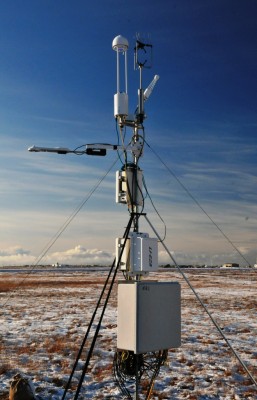
In October 2011, the ARM North Slope of Alaska site in Barrow welcomed a new eddy correlation (ECOR) flux measurement system and complementary surface energy balance system (SEBS), as well as a change to its baseline instrument suite: a methane gas (CH4) sensor for measurements of greenhouse gases emanating from the surrounding tundra.
The addition of the methane instrument to the ECOR adds important information to the measurements submitted to the AmeriFlux archive’s central data repository located at the Carbon Dioxide Information Analysis Center (CDIAC). To be in the CDIAC network, participants must submit data to the repository within one year of collection and provide a core suite of flux and micrometeorological measurements/estimates reported on 30-minute (preferred) or 1-hour intervals. Data from sub-canopy systems and replicate instrument systems on a nearby the tower are also required.
In spring 2012, a third system will be installed that includes instruments that provide additional measurements of the soil (temperature, moisture, water table), photosynthetically active radiation, and digital videos showing vegetation changes during the seasons. These measurements allow scientists to see the total picture of how the freeze/thaw cycle and soil water availability affect heat, water vapor, and methane fluxes over the tundra. ECOR and SEBS system measurements are also being obtained at ARM’s Southern Great Plains site and Tropical Western Pacific site in Darwin, Australia, but without these additional supporting measurements.

